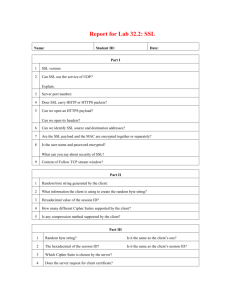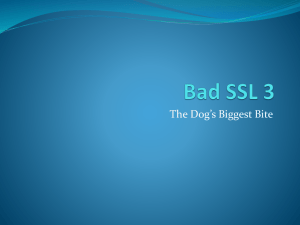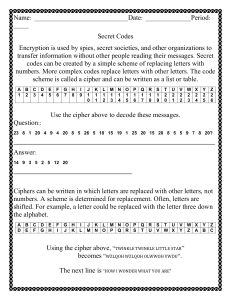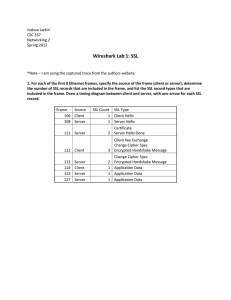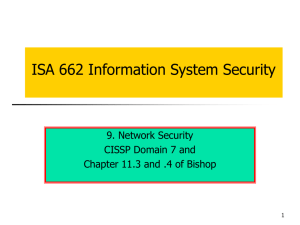Secure Socket Layer
advertisement
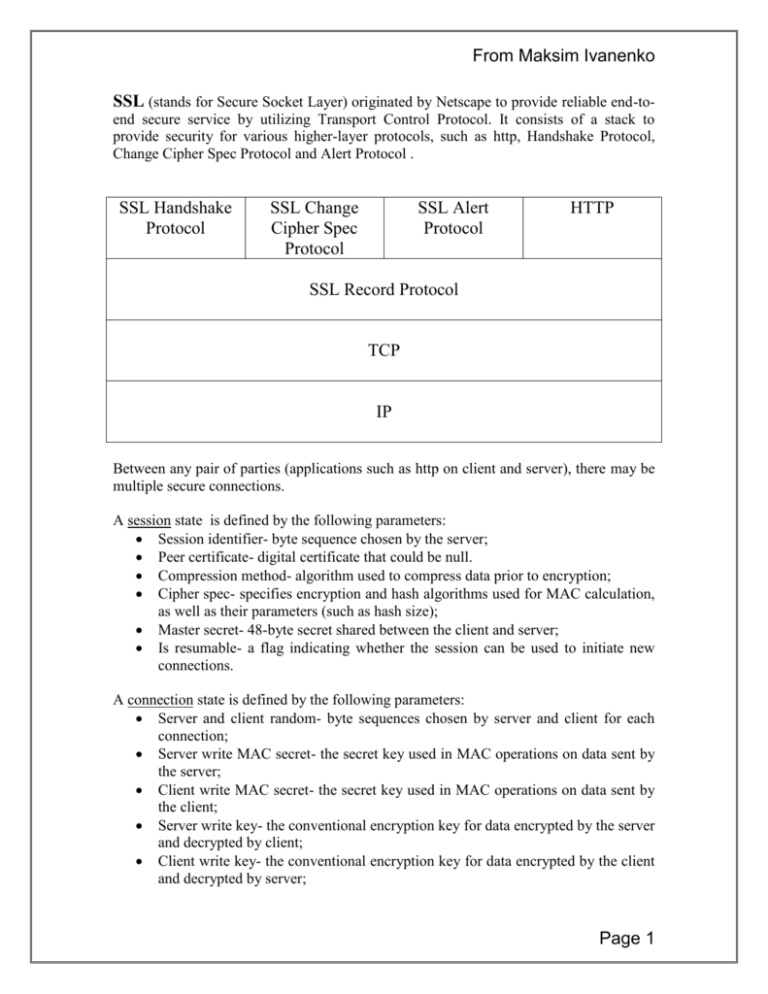
From Maksim Ivanenko
SSL (stands for Secure Socket Layer) originated by Netscape to provide reliable end-toend secure service by utilizing Transport Control Protocol. It consists of a stack to
provide security for various higher-layer protocols, such as http, Handshake Protocol,
Change Cipher Spec Protocol and Alert Protocol .
SSL Handshake
Protocol
SSL Change
Cipher Spec
Protocol
SSL Alert
Protocol
HTTP
SSL Record Protocol
TCP
IP
Between any pair of parties (applications such as http on client and server), there may be
multiple secure connections.
A session state is defined by the following parameters:
Session identifier- byte sequence chosen by the server;
Peer certificate- digital certificate that could be null.
Compression method- algorithm used to compress data prior to encryption;
Cipher spec- specifies encryption and hash algorithms used for MAC calculation,
as well as their parameters (such as hash size);
Master secret- 48-byte secret shared between the client and server;
Is resumable- a flag indicating whether the session can be used to initiate new
connections.
A connection state is defined by the following parameters:
Server and client random- byte sequences chosen by server and client for each
connection;
Server write MAC secret- the secret key used in MAC operations on data sent by
the server;
Client write MAC secret- the secret key used in MAC operations on data sent by
the client;
Server write key- the conventional encryption key for data encrypted by the server
and decrypted by client;
Client write key- the conventional encryption key for data encrypted by the client
and decrypted by server;
Page 1
From Maksim Ivanenko
Initialization vectors- used in block cipher mode for each key, initialized by
handshake protocol;
Sequence numbers- each party maintains separate sequence numbers for
transmitted and received messages for each connection. When a party
sends/receives a change cipher spec message the appropriate sequence number is
set to zero. Maximum value is 264 –1.
SSL Record Protocol provides 2 services for SSL connections:
1) Confidentiality- handshake protocol defines a shared secret key for
conventional encryption of SSL payloads;
2) Message Integrity- handshake protocol also defines a shared secret key
that is used to form a message authentication code (MAC).
Process:
Fragmentation –dividing message into manageable blocks of 214 bytes (16,384
bytes) or less;
Compression- is optional, in SLLv3 default algorithm is zero, it should ideally
shrink data when applied;
Add MAC- by computing it over compressed data with hash function;
H(MAC_write_secret||pad_2||H(MAC_write_secret||pad_1||seq_num||
SSLCompressed.type||SSLCompressed.lenghth||SSLCompressed.fra
gment))
Encryption- previous section encrypted using symmetric encryption algorithm
(IDEA, RC2/40, DES/40, DES/56, 3DES/168, Fortezza, RC4/40 or RC4/128);
Append SSL record header- content type(8 bits), major version (8 bits), minor
version (8 bits), compressed length (16 bits).
Change Cipher Spec Protocol- is simplest among SSL Record Protocols, consists of a
single byte the value 1. The sole purpose of it to cause the pending state to be copied into
the current state, which updates the cipher suite to be used on this connection.
Alert Protocol- used to convey SSL-related alerts to the peer entity, which must be also
compressed and encrypted. Each message consists of 2 bytes- first byte could be easer 1
(warning) or 2 (fatal) to determine severity; second byte indicates specific alert from list:
o unexpected_message;
o no_certificate;
o bad_record_mac;
o bad_certificate;
o decompression_failure;
o unsupported_certificate;
o handshake_failure;
o certificate_revoked;
o illegal_parameter;
o certificate_expired;
o close_notify;
o certificate_unknown.
Handshake protocol- most complex part of SSL ,which allows the server and client to
authenticate each other and to negotiate an encryption , MAC algorithm, cryptographic
Page 2
From Maksim Ivanenko
keys to be used to protect data sent in an SSL record. Handshake Protocol is used before
any application data are transmitted.
It consist of a series of messages
{three fields: type (1 byte); length (3 bytes); content (>= 1 byte)} exchanged by client
and server explained by diagram:
finished
Change_cipher_spec
Finished
Change_cipher_spec
Certificate_verify
Client_key_exchange
Certificate
Server_hello_done
Certificate_exchange
Server_key_exchange
certificate
Server_hello
Client_hello
Server ----------------------------------------Time--------------------------------------------
Client ----------------------------------------Time--------------------------------------------
Handshake protocol could be divided into 4 phases:
Establish security capabilities, including protocol version, session ID, cipher
suite, compression method and initial random numbers;
Server authentication and key exchange by sending and request of certificates;
Client Authentication and key exchange by sending and verifying certificates;
Finish by confirmation of receipt (in required keys, random numbers of
accepted cipher suite).
The shared master secret is a one-time 48-byte value (348-bits) generated for this session
by means of secure key exchange:
stage 1- pre_master_secret_key is exchanged by either RSA or Diffie-Hellman
algorithms;
stage 2- master_secret is calculated by both parties using combination of MD5,
SHA and concatenation with 2 nonce values exchanged in initial hello messages.
Page 3
